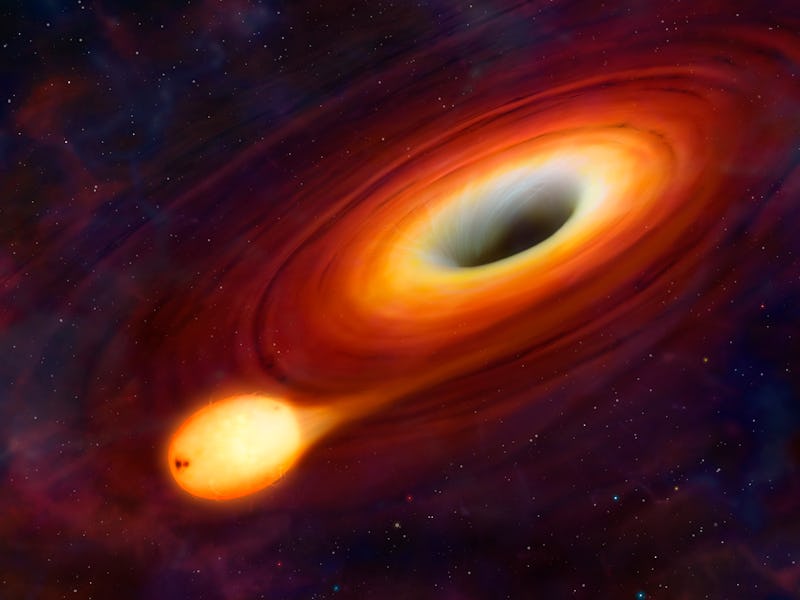A Black Hole is Ripping this Star Apart, One Planet-sized Bite at a Time
The black hole steals three Earths' worth of mass every few weeks.

In a galaxy not so far away, a star very similar to our Sun is slowly losing itself to powerful cosmic forces. The star orbits a strangely small supermassive black hole, and on every orbit, the black hole strips away enough gas to make three Earths. It’s a bizarre situation, and University of Leicester astrophysicist Phil Evans and his colleagues recently published their findings in the journal Nature Astronomy.
“I think it shows that every single time you find a new way of looking at space, you learn something new and find there’s something out there you didn’t know about before,” says Evans in a recent statement.
A Snack for a Black Hole
This image from Swift’s X-ray telescope shows the sudden bright burst of X-rays from a usually quiet patch of sky — the bright glow of material stolen from a star as it falls into a black hole.
Recently, a new instrument aboard NASA’s orbiting Swift Observatory spotted a bright flash of X-rays in a patch of sky that was usually dark and quiet — exactly the kind of short, sudden event the instrument had been designed to watch for. Evans and his colleagues kept a close eye on that patch of sky for several weeks, and they noticed that the X-ray flash repeated every 25 days, lasted for about a week, and then faded away again for a while. It turns out that the astronomers were watching the destruction of a star in slow motion.
At the heart of nearby galaxy 2MASX J02301709, about 500 million light years away, sits a tiny supermassive black hole. A doomed star about the size of our Sun circles the black hole, and every time the star’s elliptical orbit brings it too close, the black hole snatches away a huge fistful of gas — enough mass to add up to three Earths. As the stolen gas spirals inward toward the black hole’s event horizon, it heats up to nearly 3.6 million degrees Fahrenheit.
Usually, a star that ventures too near a supermassive black hole gets ripped apart and swallowed in a single violent event. But for some reason, this particular black hole is taking smaller bites. It’s not the first time astronomers have seen a supermassive black hole take its time with its meal, but it’s definitely unusual. The star still has about 330,000 Earth masses of material to give before it’s spent all its fuel.
Technically, the black hole at the center of galaxy 2MASX J02301709 is a supermassive black hole, but it’s not really so super. Most supermassive black holes weigh in at around 100 million times the mass of our Sun; the one at the heart of the Milky Way is a lightweight with a mass of only four million Suns. And the one in 2MASX (as we’ll call it for short) is super tiny: somewhere between 10,000 and 100,000 times the mass of our Sun.
This article was originally published on